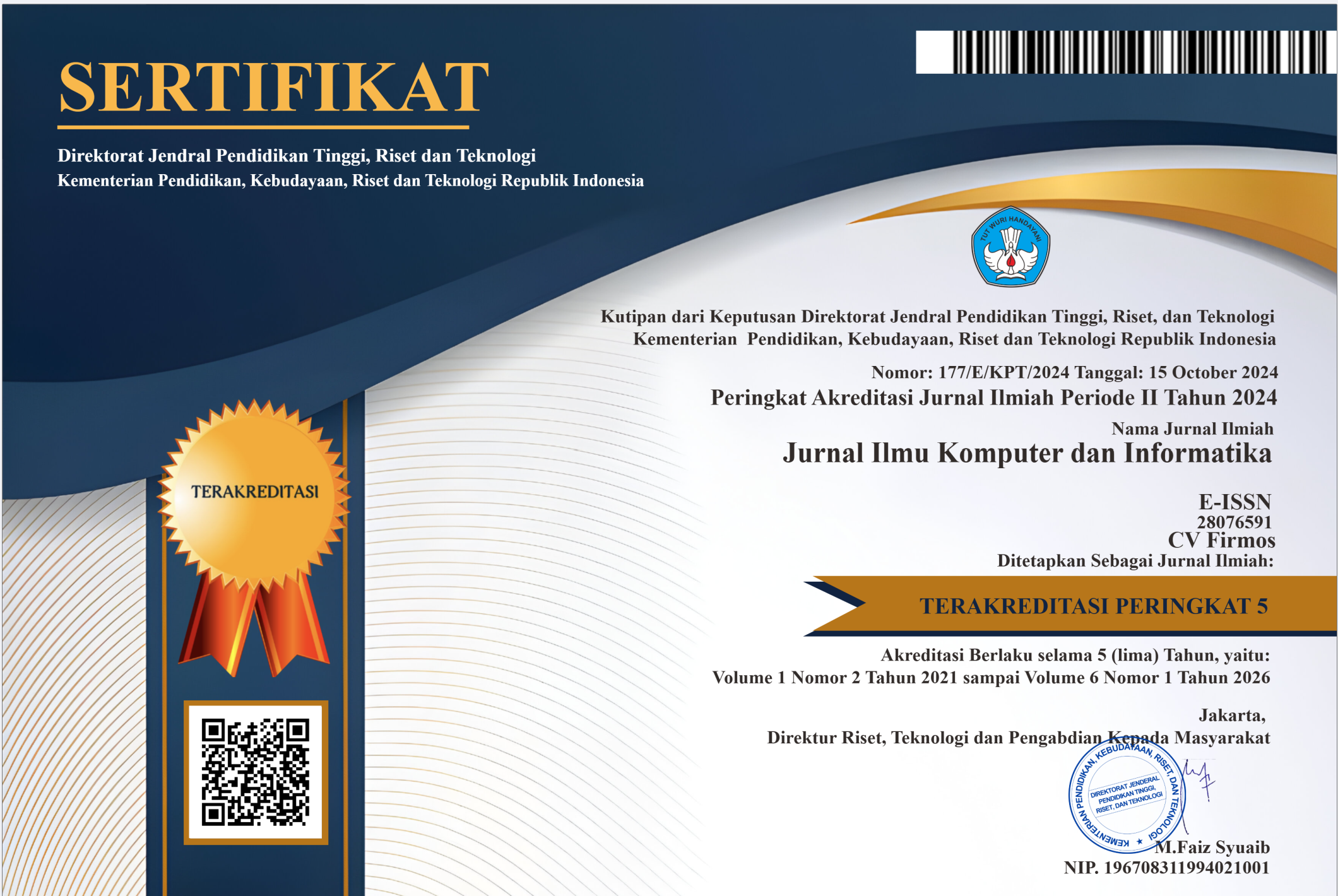Analysis Sentiment Terhadap Ginjal Akut pada Twitter Menggunakan Algoritma Random Forest
DOI:
https://doi.org/10.54082/jiki.65Keywords:
Cross Validation, Klasifikasi, Machine Learning, Particle Swarm Optimization, Random Forest, TwitterAbstract
Analisis sentimen berkaitan dengan identifikasi dan klasifikasi pendapat atau sentimen yang diungkapkan dalam teks sumber. Sosial media menghasilkan sejumlah besar data yang penuh dengan sentimen berupa tweet, update status, postingan blog maupun yang lainnya. Analisis sentimen dari data yang dihasilkan pengguna ini sangat berguna dalam mengetahui pendapat dari kerumunan. Dalam makalah ini, dilakukan analisis postingan twitter tentang Ginjal Akut menggunakan pendekatan Machine Learning, yaitu dengan menggunakan Algoritma Random Forest dan Particle Swarm Optimization. Hasil penelitian menunjukkan akurasi yang di dapat pada saat melakukan klasifikasi menggunakan algoritma Random Forest dengan Cross Validation sebesar 94.47%.
References
V. A. Fitri, R. Andreswari, and M. A. Hasibuan, “Sentiment analysis of social media Twitter with case of Anti-LGBT campaign in Indonesia using Naïve Bayes, decision tree, and random forest algorithm,” Procedia Comput Sci, vol. 161, pp. 765–772, 2019.
I. F. Rozi, S. H. Pramono, and E. A. Dahlan, “Implementasi opinion mining (analisis sentimen) untuk ekstraksi data opini publik pada perguruan tinggi,” Jurnal EECCIS (Electrics, Electronics, Communications, Controls, Informatics, Systems), vol. 6, no. 1, pp. 37–43, 2012.
A. Nayak and D. Natarajan, “Comparative study of naive Bayes, support vector machine and random forest classifiers in sentiment analysis of twitter feeds,” International Journal of Advance Studies in Computer Science and Engineering (IJASCSE), vol. 5, no. 1, p. 16, 2016.
R. Weischedel et al., “White paper on natural language processing,” in Speech and Natural Language: Proceedings of a Workshop Held at Cape Cod, Massachusetts, October 15-18, 1989, 1989.
A. Nayak and D. Natarajan, “Comparative study of naive Bayes, support vector machine and random forest classifiers in sentiment analysis of twitter feeds,” International Journal of Advance Studies in Computer Science and Engineering (IJASCSE), vol. 5, no. 1, p. 16, 2016.
S. Shalev-Shwartz and S. Ben-David, Understanding machine learning: From theory to algorithms. Cambridge university press, 2014.
W. Lin, Z. Wu, L. Lin, A. Wen, and J. Li, “An ensemble random forest algorithm for insurance big data analysis,” Ieee access, vol. 5, pp. 16568–16575, 2017.
M. Tsytsarau and T. Palpanas, “Survey on mining subjective data on the web,” Data Min Knowl Discov, vol. 24, pp. 478–514, 2012.
W. Medhat, A. Hassan, and H. Korashy, “Sentiment analysis algorithms and applications: A survey,” Ain Shams engineering journal, vol. 5, no. 4, pp. 1093–1113, 2014.
A. Agarwal, B. Xie, I. Vovsha, O. Rambow, and R. J. Passonneau, “Sentiment analysis of twitter data,” in Proceedings of the workshop on language in social media (LSM 2011), 2011, pp. 30–38.
K. Singh, R. Nagpal, and R. Sehgal, “Exploratory data analysis and machine learning on titanic disaster dataset,” in 2020 10th International Conference on Cloud Computing, Data Science & Engineering (Confluence), 2020, pp. 320–326.
S. B. Kotsiantis, D. Kanellopoulos, and P. E. Pintelas, “Data preprocessing for supervised leaning,” Int J Comp Sci, vol. 1, no. 2, pp. 111–117, 2006.
K. Choudhary and S. Wadhwa, “Glaucoma detection using cross validation algorithm,” in 2014 Fourth International Conference on Advanced Computing & Communication Technologies, 2014, pp. 478–482.
K. Chaudhary, P. Maheshwari, and S. Wadhwa, “Glaucoma detection using cross validation algorithm: A comparitive evaluation on rapidminer,” in 2014 IEEE Conference on Norbert Wiener in the 21st Century (21CW), 2014, pp. 1–5.
W. Lin, Z. Wu, L. Lin, A. Wen, and J. Li, “An ensemble random forest algorithm for insurance big data analysis,” Ieee access, vol. 5, pp. 16568–16575, 2017.
Y. Liu, Y. Wang, and J. Zhang, “New machine learning algorithm: Random forest,” in Information Computing and Applications: Third International Conference, ICICA 2012, Chengde, China, September 14-16, 2012. Proceedings 3, 2012, pp. 246–252.
Y. Shi and R. Eberhart, “A modified particle swarm optimizer,” in 1998 IEEE international conference on evolutionary computation proceedings. IEEE world congress on computational intelligence (Cat. No. 98TH8360), 1998, pp. 69–73.
R. Poli, J. Kennedy, and T. Blackwell, “Particle swarm optimization,” Swarm intelligence, vol. 1, no. 1, pp. 33–57, 2007.
B. Xue, M. Zhang, and W. N. Browne, “Particle swarm optimization for feature selection in classification: A multi-objective approach,” IEEE Trans Cybern, vol. 43, no. 6, pp. 1656–1671, 2012.
W. Richert, Building machine learning systems with Python. Packt Publishing Ltd, 2013.
J. Ling, I. P. E. N. Kencana, and T. B. Oka, “Analisis Sentimen Menggunakan Metode Naïve Bayes Classifier Dengan Seleksi Fitur Chi Square,” E-Jurnal Matematika, vol. 3, no. 3, pp. 92–99, 2014.
Downloads
Published
How to Cite
Issue
Section
License
Copyright (c) 2024 Hadi Mirojul Falah, Muhammad Ridwan Jamil, Ahmad Taufik, Marten Botha, Nova Agustina

This work is licensed under a Creative Commons Attribution 4.0 International License.


















